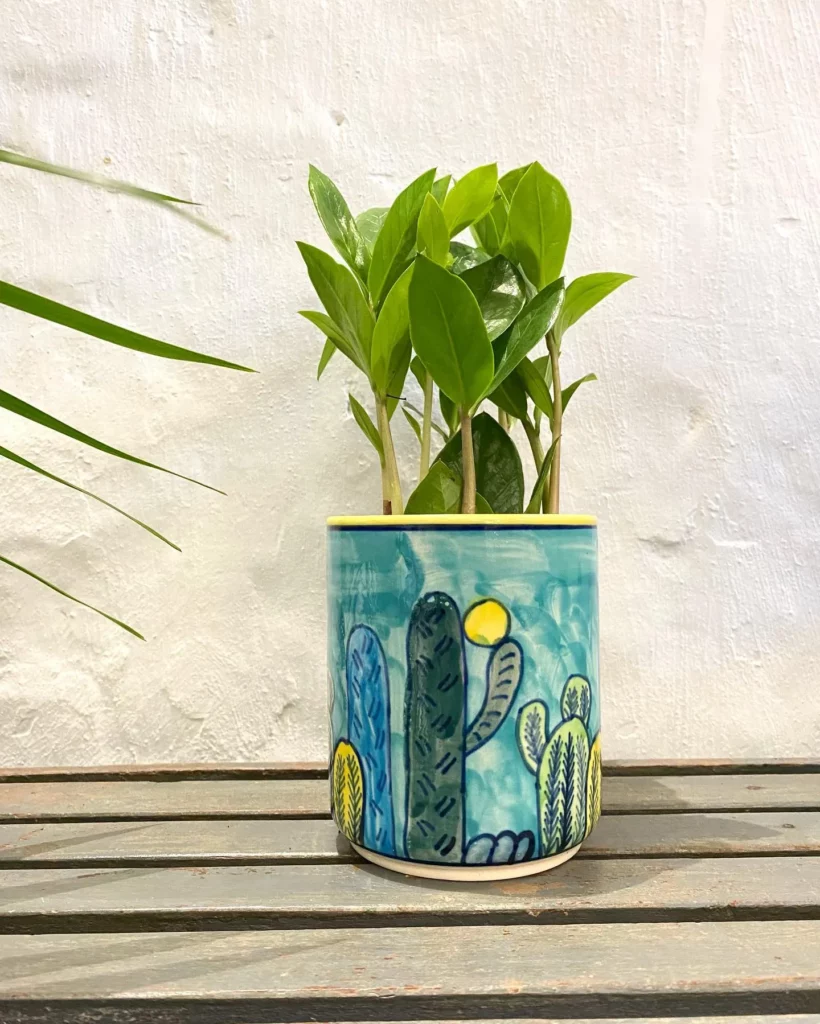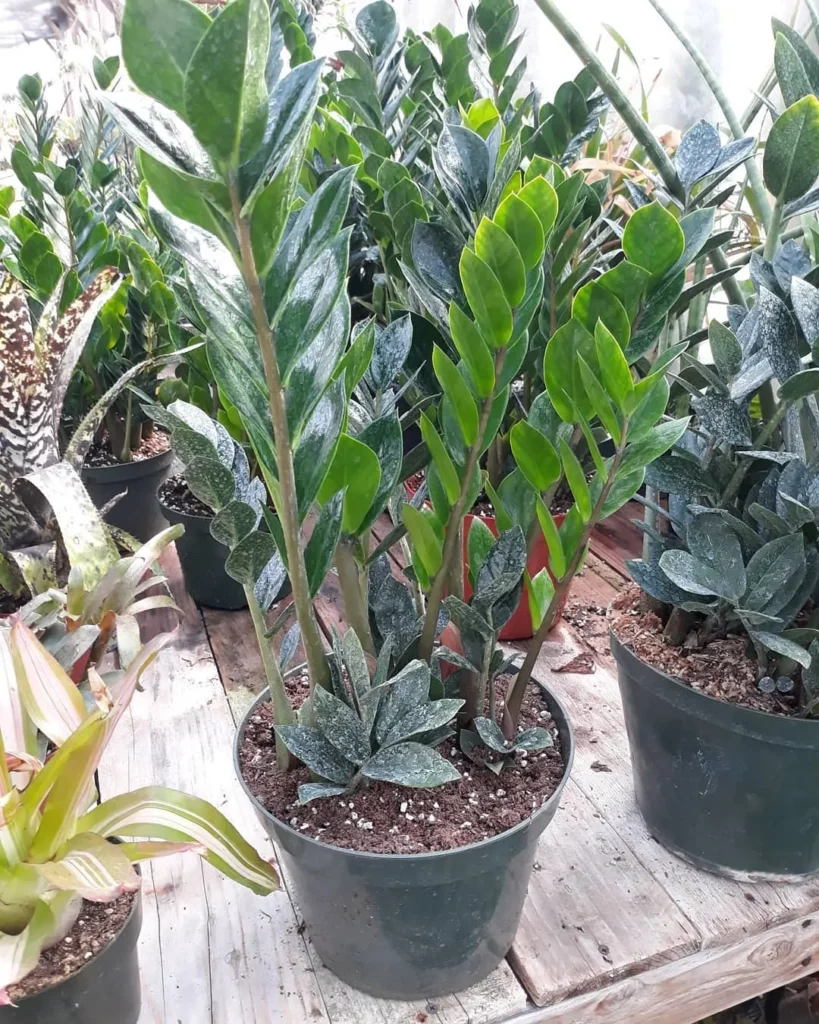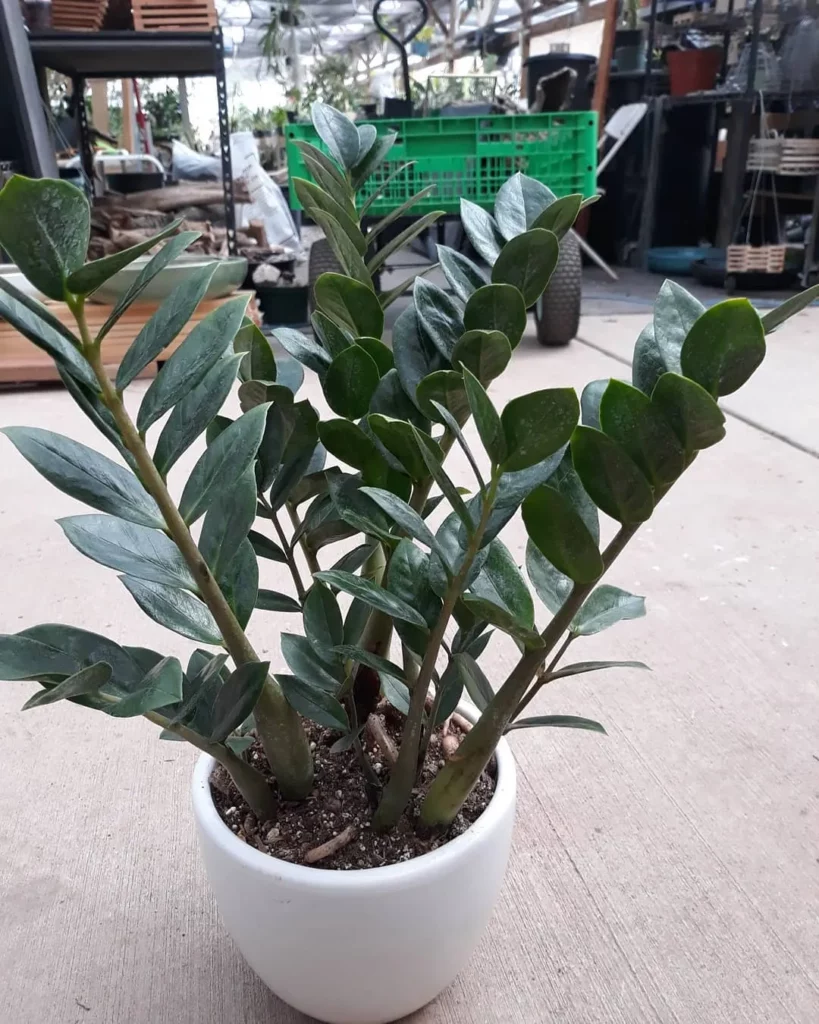The ZZ Plant, or Zanzibar Gem, is a low-maintenance, elegant houseplant from East Africa with shiny, oval leaves. It thrives in bright, indirect sunlight and requires watering only when the soil dries out, approximately every two weeks.
Ideal care includes well-draining soil, occasional half-strength fertilizer during the growing season, and minimal pruning to remove dead leaves. Susceptible to pests like mealybugs and aphids, it benefits from cautious fertilization and can be propagated by division or stem cuttings, needing repotting every 2-3 years.
No products found.
Understanding the ZZ Plant: A Low-Maintenance Beauty



The ZZ plant, scientifically known as Zamioculcas zamiifolia, is a true beauty that requires minimal effort to thrive. With its shiny, oval-shaped leaves that gracefully grow upwards, this low-maintenance houseplant has gained popularity among indoor garden enthusiasts.
One of the most appealing aspects of the ZZ plant is its ability to thrive in various lighting conditions. While it prefers bright, indirect sunlight, it can adapt to lower-light environments as well. The plant’s tolerance to different light levels makes it an excellent choice for those hard-to-fill corners and spaces where other plants may struggle.
No products found.
Another reason why the ZZ plant is a favorite among busy individuals is its drought-tolerant nature. Watering requirements are minimal, as the plant only needs to be watered once the soil has completely dried out.
This usually happens every two weeks, but it’s important to ensure thorough watering when the time comes. Water should be poured until it runs out of the pot’s drainage hole, allowing any excess water to escape.
The ZZ plant prefers well-draining soil, so be sure to choose a potting mix that promotes good drainage. A mixture of peat moss, perlite, and sand is ideal.
Creating the Ideal Environment: Light, Water, and Soil

To ensure your ZZ plant thrives, it’s important to provide it with the right amount of light, water, and well-draining soil. This section will guide you on how to create the ideal environment for your Zanzibar Gem, also known as the ZZ plant, to flourish.
No products found.
ZZ Plant Light, Watering, and Soil Requirements
| Light | Watering | Soil |
|---|---|---|
| Bright, indirect sunlight | Water when soil is dry | Well-draining soil mix |
| Avoid direct sunlight | Thoroughly saturate soil | Loose and well-aerated |
Nurturing Growth: Fertilization and Pest Control



Regular maintenance, including fertilization, propagation, and pest control, is essential for nurturing the growth of your ZZ plant. Providing the right nutrients and protecting your plant from pests will ensure it remains healthy and vibrant.
Fertilization
ZZ plants benefit from regular fertilization during their active growing season. Using an indoor plant fertilizer diluted to half-strength, apply it once or twice to your ZZ plant.
No products found.
A recommended ratio of 3-1-2 for the N-P-K nutrients will help promote growth and overall plant health. It’s important to note that overfertilization can lead to fertilizer burn, so always follow the instructions on the fertilizer packaging.
Propagation
Propagating ZZ plants can be done through division or stem cuttings. Dividing the plant involves separating the rhizomes, or underground stems, and planting them in separate pots.
Stem cuttings can be taken from healthy, mature stems and planted in well-draining soil. Both methods can be successful, and propagating your ZZ plant allows you to create new plants or rejuvenate an existing one.
Pest Control
While ZZ plants are generally pest-free, they can occasionally be affected by mealybugs, scale, fungus gnats, and aphids. Regularly inspect your plant for signs of infestation, such as sticky residue, yellowing leaves, or webbing.
No products found.
To control these pests, you can use natural remedies like neem oil or insecticidal soap. Applying these treatments according to the instructions will help eliminate pests and keep your ZZ plant healthy and pest-free.
Pruning and Cleaning: Enhancing the ZZ Plant’s Appearance

Pruning and cleaning play a crucial role in enhancing the appearance of your ZZ plant. Regular maintenance tasks will not only keep your plant looking neat and tidy but also promote its overall health and vitality.
By following a few simple steps, you can ensure that your ZZ plant remains a beautiful addition to your indoor space.
| Pruning and Cleaning Tips: | |
|---|---|
| 1 | Inspect your ZZ plant regularly for dry or dead leaves. |
| 2 | Remove dry or dead leaves by cutting them off at the base with clean pruning shears. |
| 3 | Use a damp cloth or sponge to gently clean the leaves, removing dust and debris. |
| 4 | Avoid using harsh cleaning agents or chemicals that can damage the leaves. |
| 5 | Allow the plant to dry naturally before placing it back in its desired location. |
Conclusion: Growing and Thriving with the Zanzibar Gem
Congratulations! You are now equipped with the knowledge to grow and thrive with the Zanzibar Gem, an easy-to-care-for plant that will bring beauty to any indoor space.
The Zanzibar Gem, also known as the ZZ plant or Zamioculcas zamiifolia, is a low-maintenance houseplant that can easily adapt to a variety of indoor environments. Its shiny, oval-shaped leaves grow upward, adding a touch of elegance to any room.
One of the reasons the ZZ plant is so popular is its ability to thrive even in less-than-ideal conditions. It can tolerate low light levels, but prefers bright, indirect sunlight. Just be sure to avoid direct sunlight, as it can scorch the leaves.
As a drought-tolerant plant, the ZZ plant only needs to be watered once the soil has dried out completely, usually every two weeks. Remember to water thoroughly and allow excess water to drain out of the pot.
Fertilization is important for the growth and health of the ZZ plant. During its active growing season, which typically occurs in spring and summer, you can use an indoor plant fertilizer that is diluted to half-strength.
Apply the fertilizer once or twice, following the instructions on the product label. Repotting is necessary every two to three years if the plant’s roots become crowded. ZZ plants prefer well-draining soil, so be sure to use a potting mix that allows water to flow freely.
Pest issues are rare with the ZZ plant, but it is important to keep an eye out for mealybugs, scale, fungus gnats, and aphids. Regular cleaning with a damp cloth will help maintain the plant’s shine, while pruning can be done as needed to remove any dry or dead leaves.
The ZZ plant can also be propagated through division or stem cuttings, allowing you to create more plants to enjoy or share with others.
With its resilience and ability to thrive in various indoor environments, the Zanzibar Gem is truly an easy-to-care-for plant. Whether you are a beginner in indoor gardening or an experienced plant parent, the ZZ plant is sure to bring beauty and greenery to your home or office.
Make sure to check out our article on White Variegata ZZ Plant: Step-by-Step Care Journey. And after reading that ZZ Plant article, check out our article on Zenzi ZZ Plant: Harmonizing Its Care Needs.
FAQ
Q: Is the ZZ plant a low-maintenance houseplant?
A: Yes, the ZZ plant is known for being a low-maintenance houseplant that is easy to care for.
Q: What lighting conditions does the ZZ plant prefer?
A: The ZZ plant can thrive in various lighting conditions, but it prefers bright, indirect sunlight. Direct sunlight should be avoided as it can scorch the leaves.
Q: How often should I water my ZZ plant?
A: The ZZ plant is drought-tolerant and only requires watering once the soil dries out completely, usually every two weeks. It’s important to water thoroughly until water runs out of the drainage hole at the bottom of the pot.
Q: What type of soil does the ZZ plant prefer?
A: ZZ plants prefer well-draining soil.
Q: Does the ZZ plant require fertilization?
A: Yes, ZZ plants can be fertilized with indoor plant fertilizer diluted to half-strength once or twice during their active growing season.
Q: What pests are ZZ plants prone to?
A: ZZ plants can be prone to mealybugs, scale, fungus gnats, and aphids.
Q: How often should ZZ plants be pruned?
A: Pruning is not required often, but any dry or dead leaves can be removed throughout the year.
Q: How can I maintain the shine of my ZZ plant?
A: Regular cleaning with a damp cloth will help maintain the plant’s shine.
Q: How can ZZ plants be propagated?
A: ZZ plants can be propagated through division or stem cuttings.
Q: How often should ZZ plants be repotted?
A: ZZ plants should be repotted every two to three years if the roots become crowded.
Q: What is the recommended fertilizer ratio for ZZ plants?
A: A recommended ratio of 3-1-2 for the N-P-K nutrients is ideal for ZZ plant fertilization.
Q: When should I fertilize my ZZ plant?
A: Fertilizing should be done during the active growing season, with a reduced rate during the fall and no fertilization during winter dormancy.
Q: What should I do if my ZZ plant shows signs of overfertilization?
A: Overfertilization can lead to fertilizer burn. If you notice signs of overfertilization, it’s best to stop fertilizing and flush the soil with water to leach out excess nutrients.





